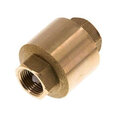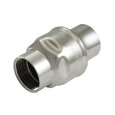Swing Check Valve
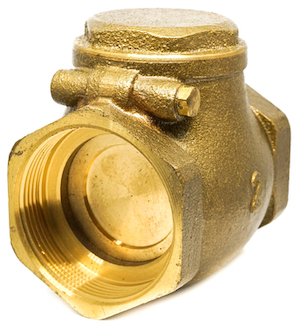
Figure 1: Swing check valve
Swing check valves are common check valves used in water and wastewater applications. They are cost-effective, are made of a wide range of materials, and have different designs for specific functionality. This article focuses on a swing check valve's applications, advantages, and disadvantages to help users ensure whether these valves are suitable for an application. For a comprehensive understanding of check valves, read our guide on check valves!
Table of contents
- Swing check valve operation principle
- Types of swing check valves
- Materials
- Swing check valve installation
- Advantages and disadvantages
- Swing check valves applications
- Comparison with other check valve types
- FAQs
View our online selection of check valves!
Swing check valve operation principle
An inline swing check valve has a disc (Figure 2 labeled B) that can swing on a hinge (Figure 2 labeled A). When closed, the disc rests on the valve seal (Figure 2 labeled C), which is on the inlet side of the valve. When the pressure of the media flowing into the valve is higher than the valve’s cracking pressure, the disc raises, the valve opens, and media is allowed to flow through the valve. When the inlet pressure drops, the valve swings shut to block any downstream backflow that may occur.
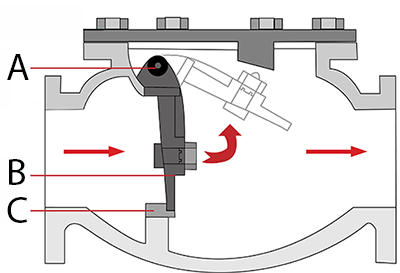
Figure 2: Swing check valve operation and components: hinge (A), disc (B), and seal (C).
Types of swing check valves
There are several types of swing check valves with their pros and cons. While some are interchangeable for certain applications, a good understanding of the types can help select the most efficient swing check valve for a given application.
Wafer swing check valve
As seen in figure 3, a wafer swing check valve has a very short face-to-face, which is the distance between the inlet and the outlet. The short face-to-face makes clogging in the valve less likely. Therefore, wafer swing check valves are ideal for small installation spaces and viscous and slurry media.
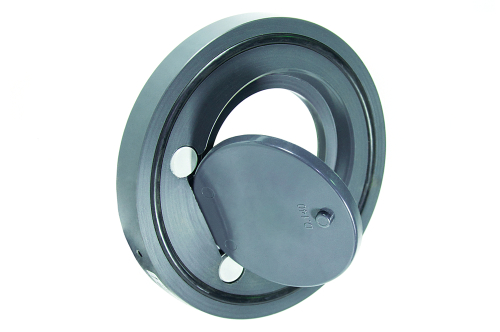
Figure 3: Wafer swing check valve
Tilting disc swing check valve
Tilting disc swing check valves use a disc that rests in the closed position at an angle rather than vertically. The disc floats in the flowing media. This design has two significant benefits. First, the valve closes faster and reduces the effect of water hammer. Second, the valve can open at very low flow pressures.
Y swing check valve
Y swing check valves are suitable for applications similar to in-line swing check valves. As seen in figure 4, the added opening that makes the Y shape allows a user to investigate the inside of the valve without removing it from the system.
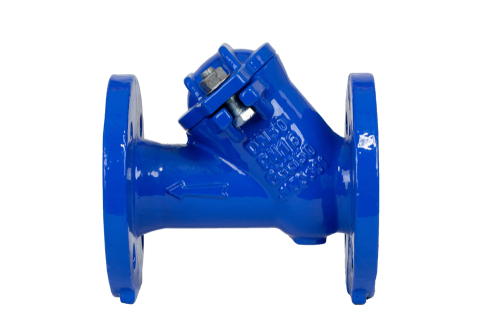
Figure 4: Y swing check valve
Materials
Materials used to construct swing check valve components are the same materials used in producing many valve types. Therefore, swing check valves are suitable for various applications concerning pressure, temperature, and the environment. The following is an overview of some of the materials commonly used. Read our chemical resistance guide to learn more about the chemical properties of the following materials and others.
Valve body and disc
- Stainless steel: Stainless steel valves are strong and resistant to corrosion and rust. In systems that don’t have high pressures or temperatures, stainless steel valves are not cost-effective. Stainless steel valves are resistant to corrosion and rust except for in saltwater applications.
- Ductile iron: Ductile iron valves are strong, pressure resistant, and cost-effective. However, they are vulnerable to rust.
- Brass: Brass valves are suitable for high-temperature and high-pressure applications and are more cost-effective than stainless steel valves.
- Bronze: Bronze is cost-effective, strong, and resists rust.
- Monel: Monel valves are suitable for underwater applications and are resistant to acids.
- Inconel: Inconel is suitable for extreme environments and resistant to corrosion and heat.
- PVC: PVC valves are the most cost-effective choice for applications that have media temperatures below 60 °C (140 °F).
- ABS: ABS is stronger than PVC and suitable for temperatures up to 100 °C (212 °F).
Valve seat
- FKM: FKM seats age well, are suitable for petroleum systems, and have high abrasion resistance. FKM seats have a working temperature range from -20 °C to 230 °C ( -4 °F to 446 °F).
- Teflon (PTFE): Teflon seats have a low coefficient of friction and are chemical resistant. These seats have a working temperature range from -260 °C to 260 °C ( -436 °F to 500 °F).
- NBR: NBR seats are resistant to oil and have high abrasion resistance. These seals have a working temperature range from -35 °C to 120 °C ( -31 °F to 248 °F).
- EPDM: EPDM seats are applicable for water systems and not for oil and gas systems. Their working temperature range is from -40 °C to 150 °C ( -40 °F to 302 °F).
Swing check valve installation
Swing check valve installation can be horizontal or vertical, facing upwards. However, if a swing check valve is installed on a vertical pipe where the flow is upwards against gravity, the disk may slam against the seat when the flow stops, potentially leading to water hammer. If the flow is downwards as in the case of boiler supply lines and mining applications with limited spacing, the swing check valve will always be open and hence does not deliver its function. Therefore, swing check valves are not preferred in vertical pipe runs and these valves are installed horizontally in most cases. The installation specifics depend on the connection type: threaded, flanged, or welded. However, take the following steps for any swing check valve.
- Ensure that there is no foreign material inside the valve, for example, packing material.
- Push the disc away from the seat to make sure it functions properly.
- Align the valve in the correct position by facing the arrow in the flow direction.
Threaded connection
Install a swing check valve with threaded connections by screwing its ends into the piping. Start by screwing the valve into both ends of the piping until it is hand-tight. Then, use a wrench to further tighten the valve by one half turn. Further tightening can damage the valve.
Pay close attention to the threading when starting to screw in the valve. If the valve threading and the pipe threading do not align correctly, cross threading can occur and damage threading.
Flanged connection
Installing a dismantling joint to one end of the valve is a good practice. Dismantling joints ease installation and make valve maintenance, repair, and replacement easier.
Ensure that the pipe flanges are parallel before bolting the valve flanges to the pipes. When tightening the bolts, tighten them crosswise. Tightening bolts in consecutive order will put undue stress on the valve.
Welded connection
Preparing the piping before welding by cutting it square (perpendicular to the valve surface, not angular) and deburring the insides and the outsides of the pipe ends. Finally, polish the pipe ends with sandpaper and clean them with solvent.
Use solder flux to clean the pipe ends further and inside the valve end connections. Support the pipes properly to avoid undue stress on the valve.
To protect the valve components during the soldering process, aim the torch away from the valve body. Continuously move the flame to avoid heat spots and damage to the valve.
Testing
After installing the valve, run media through it to ensure it flows in the right direction. Also, check to ensure there is no leaking.
Advantages and disadvantages
Advantages
- The assembly for the hinge and disc are protected from the flow, so viscous or slurry media is less able to attach to the assembly and hinder the closure of the valve.
- Swing check valves are available in large sizes. Typically the size range is 2 in. NB (50.8 mm) to 24 in. NB (609.6 mm).
Disadvantages
- Unsuitable for frequent flow reversal and pulsating flow.
- Prone to water hammer issues.
- Swing check valve closure is typically slower than other check valves (e.g., lift and spring check valves).
- Less suitable for vertical flow.
Swing check valves applications
Swing check valves are the most common valves in water supply, wastewater pumping, and slurry transport systems. Clogging is less likely in swing check valves except for solids that can build up over a period of time. In this case, swing check valves are relatively easy to get into and clean out without needing to remove the valve from the system.
Conventional swing check valves are unsuitable for low-pressure applications, but tilting swing check valves are. The variety of swing check valves available makes this type suitable for many low-risk applications that can allow for a minimal amount of backflow if the valve does not close fast enough.
Comparison with other check valve types
Ball check valve vs swing check valve
Ball check valves use a ball that rests on the valve seat. When media flows through the valve, the ball moves off the seat, and media flows through the valve. The ball falls back onto the seat when the flow pressure drops low enough, or backflow occurs.
Ball and swing check valves are both cost-effective and commonly used in water and wastewater applications. Also, they are both suitable for viscous media. An important difference is that the weight of the ball in the ball check valve can be specifically selected. If the ball is too heavy, the valve will close while media is still flowing through it. If the ball is too light, the valve will not close fast enough, and more backflow can get through the valve.
Spring check valve vs swing check valve
The spring in a spring check valve is the primary component controlling the valve’s cracking pressure and closure. As inlet pressure drops, the spring begins to close the valve until the pressure drops below the valve’s cracking pressure, and the valve fully closes. Apart from the construction, the main differences between both valve types are listed below:
- A spring check valve is ideal for reducing loud noises that occur when a swing check valve closes rapidly. Spring check valves are also called ‘silent’ check valves and they are potentially resistant to water hammer. Swing check valves are prone to water hammer issues.
- As the spring controls closure, a spring check valve can be installed in any orientation (vertical or horizontal) so long as the arrow on the valve body is facing the flow direction. Swing check valves are preferred only in horizontal piperuns.
- Spring check valves typically cost more than swing check valves.
- Spring check valves have a lower flow capacity than swing check valves.
FAQs
What is the purpose of a swing check valve?
A swing check valve allows media to flow in one direction. When the media’s pressure drops, the valve closes and prevents backflow.
Is a swing or spring check valve better?
Swing check valves are more cost-effective than spring check valves. However, installation of spring check valves is possible in more orientations.
Where should a swing check valve be installed?
A swing check valve should be installed wherever backflow can contaminate media or damage system parts.




